Euphorbia Ingens (Candelabra Tree) Care & Propagation Guide
Written by Iris
Oct 14 2021
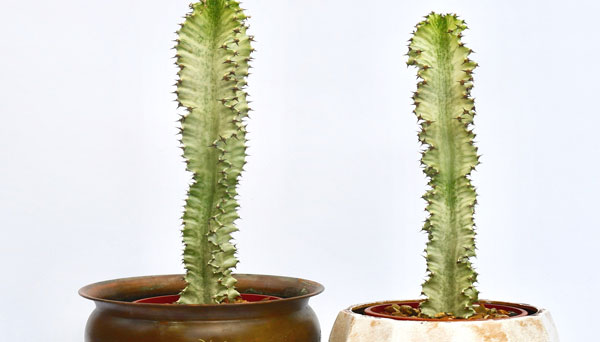
Euphorbia ingens (Candelabra tree) is a prickly cactus-like plant that is considered a lucky houseplant. Like cactus, Euphorbia ingens has no leaves, but this plant is characterized by segmented arms growing from a trunk and bright yellow flowers on the tips of branches in late spring. This slow-growing, spiny evergreen succulent is very easy to care for. Place Euphorbia ingens in a place that receives direct sunlight and keeps warm continuously and hardly needs water to nourish it.
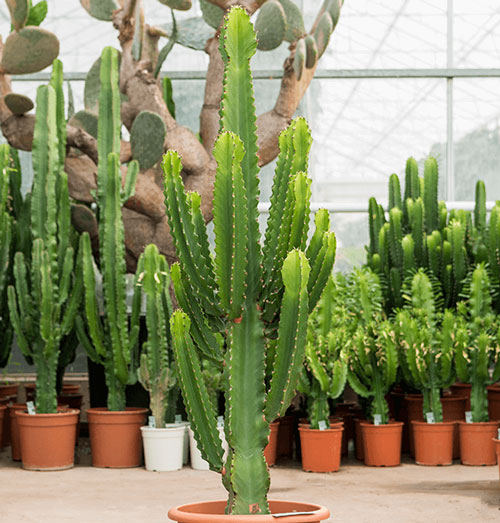
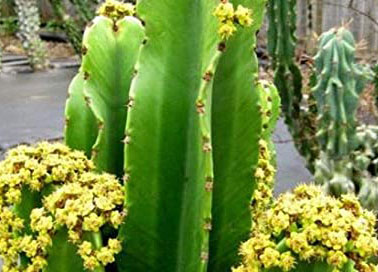
In the winter, you need to water your Euphorbia ingens less frequently. Instead, give them enough water to provide the bare minimum moisture and to keep them from wilting. During the warmer seasons, the best time to water your euphorbias is in the evening.
But you can also do this in the morning before the sun goes up and the temperatures rise, and may even be a better idea during the winter months. Euphorbia ingens (Candelabra tree) that are grown in containers or pots will need more frequent watering in hot weather. Sometimes, you will need to water two or three times a week.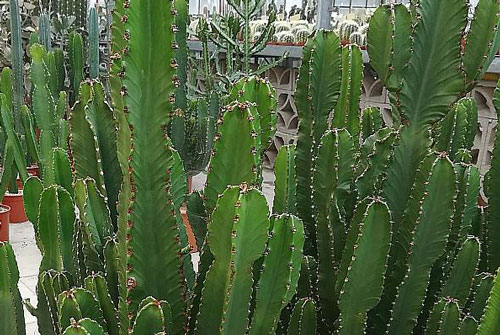
Most Popular Types of Euphorbia Varieties. This small tree or shrub features upright succulent stems with beautiful blazing red leaves that look like flowers. It is one of the most beautiful houseplants that you can grow.
Euphorbia abyssinica
Desert Candle is a tree-like succulent with a thick green trunk that becomes woody with maturity. It grows flowers without petals having yellow bracts.
Euphorbia tirucalli
The cylindrical-shaped branches of this plant look a lot like a pencil. Though it is usually green, but keep it in full sun and it will take a fiery red hue!
Euphorbia trigona
You must have seen this plant in a lot of pictures and movies! It looks a lot like cactus, but is actually a succulent! And yes, it can grow up to an impressive height of 6-8 feet.
Euphorbia lactea
This small shrub showcases upright green stems in cross-sections with a pale center. They have showy white and lime green patterns, with a couple of blackthorns.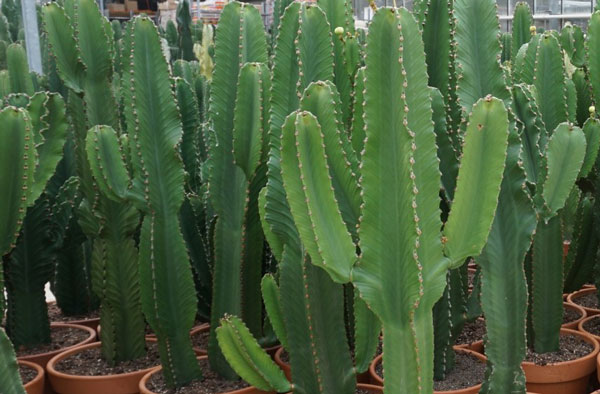
Where to Grow Euphorbia Ingens (Candelabra Tree)How to Grow Euphorbia Ingens (Candelabra Tree)How to Care for Euphorbia Ingens (Candelabra Tree)Euphorbia Ingens LightingEuphorbia Ingens Soil CareEuphorbia Ingens WateringEuphorbia Ingens Temperature & Humidity CareEuphorbia Ingens Fertilizer CareEuphorbia Ingens PruningEuphorbia Ingens Pests & DiseasesVarieties of Euphorbia ingens (Candelabra tree)Euphorbia ingens (Candelabra tree) FAQIs Euphorbia ingens Toxic to Pets?How fast do Euphorbia ingens grow?Why is my Euphorbia ingens turning yellow?
Where to Grow Euphorbia Ingens (Candelabra Tree)
Euphorbia ingens (Candelabra tree) need strong light. When planting this succulent type in a garden, make sure it gets sunlight. Full to partial sun is the best for its growth. It is better to grow euphorbia ingens outdoor rather than indoor. Euphorbia ingens prefers a warm climate. Euphorbia ingens can survive at zone native to the plant. If you live in a cold area, it is better to plant candelabra tree in an indoor environment. As long as it gets enough sunlight, the Euphorbia ingens will grow happily.
How to Grow Euphorbia Ingens (Candelabra Tree)
Propagate Euphorbia ingens from seeds. However, it is not only difficult to find the seeds but generally germinating them is a challenge. Therefore the best way to propagate these plants is through cuttings.- Wear gloves before handling the plants because it is naturally poisonous.
- Use a sharp knife to take cuttings from around the branching point.
- Hold it under cold running water to wash away the milky latex.
- Allow the cutting to dry for about two weeks. You will notice a callus over the cut ends.
- Plant them in preferred soil and see your Euphorbia ingens grow into a beautiful tree.

How to Care for Euphorbia Ingens (Candelabra Tree)
Euphorbia Ingens Lighting
Euphorbia ingens (Candelabra tree) is happiest in bright sunlight. He will prefer a south or west facing window with as much light as possible. Place Euphorbia ingens a few feet away from any sunny window where he can enjoy as much sunlight as possible. Lighting-wise Euphorbia ingens pairs perfectly with Sasha, the citrus tree and Alex.Euphorbia Ingens Soil Care
Euphorbia ingens (Candelabra tree) grows well in well-draining, gritty soils or cactus potting mix. Euphorbia ingens are not particular about soil pH, but they cannot tolerate wet soil.Euphorbia Ingens Watering
The only strict rule when it comes to watering succulents is not to overwater them. Succulent euphorbias like it when they are dried out before you water them again. Euphorbia ingens (Candelabra tree) can even survive drought, but not for a long period. However, this does not mean that they need it. To make sure that the soil has dried out, stick your finger an inch or so into the potting mixture and check if it is damp. If it is dry to the touch, you can water the Euphorbia ingens plant again and if not, you can wait until there is no more moisture.In the winter, you need to water your Euphorbia ingens less frequently. Instead, give them enough water to provide the bare minimum moisture and to keep them from wilting. During the warmer seasons, the best time to water your euphorbias is in the evening.
But you can also do this in the morning before the sun goes up and the temperatures rise, and may even be a better idea during the winter months. Euphorbia ingens (Candelabra tree) that are grown in containers or pots will need more frequent watering in hot weather. Sometimes, you will need to water two or three times a week.
Euphorbia Ingens Temperature & Humidity Care
When it comes to temperature, tolerance may vary from one species to another. While Euphorbia ingens (Candelabra tree) generally enjoy high summer temperatures, the minimum winter temperatures they can tolerate vary. For example, species from West and Central Africa, as well as from the tropical and subtropical regions of America, require temperatures between 13°C to 15°C (55°F to 60°F) in the winter. Meanwhile, species from East Africa and Madagascar need temperatures between 10°C to 13°C (50°F to 55°F). Euphorbia Ingens will fit perfectly into the climate of the ordinary home. They like it dry, so need for misting.Euphorbia Ingens Fertilizer Care
Feed your Euphorbia ingens (Candelabra tree) in the spring when new growth begins. Use a water-soluble fertilizer in a 10-10-10 NPK formulation, diluted to half the recommended strength.Euphorbia Ingens Pruning
Use a sharp knife to take Euphorbia ingens cuttings from around the branching point. Hold it under cold running water to wash away the milky latex. Allow the cutting to dry for about two weeks. You will notice a callus over the cut ends.Euphorbia Ingens Pests & Diseases
It is important to mention that the Candelabra tree is a poisonous plant. If ingested, the latex can pose certain health threats. It can cause skin irritation and even blindness on contact. Since it is considered to be toxic, a lot of people avoid planting them in areas accessible to children and pets. There is a bright side to the toxic nature of this plant – the poisonous latex makes sure that pests bring no damage to the Euphorbia ingens (Candelabra tree) plants.
Varieties of Euphorbia ingens (Candelabra tree)
Euphorbia pulcherrimaMost Popular Types of Euphorbia Varieties. This small tree or shrub features upright succulent stems with beautiful blazing red leaves that look like flowers. It is one of the most beautiful houseplants that you can grow.
Euphorbia abyssinica
Desert Candle is a tree-like succulent with a thick green trunk that becomes woody with maturity. It grows flowers without petals having yellow bracts.
Euphorbia tirucalli
The cylindrical-shaped branches of this plant look a lot like a pencil. Though it is usually green, but keep it in full sun and it will take a fiery red hue!
Euphorbia trigona
You must have seen this plant in a lot of pictures and movies! It looks a lot like cactus, but is actually a succulent! And yes, it can grow up to an impressive height of 6-8 feet.
Euphorbia lactea
This small shrub showcases upright green stems in cross-sections with a pale center. They have showy white and lime green patterns, with a couple of blackthorns.

Euphorbia ingens (Candelabra tree) FAQ
Is Euphorbia ingens Toxic to Pets?
Be really careful when handling your Euphorbia ingens (Candelabra tree). It is recommended to wear garden gloves when handling to protect yourself. Even the smallest amount of african milk from the tree is very toxic, it is white, latex sap can product painful irritation to the skin. Keep this plant out of reach from your pets.How fast do Euphorbia ingens grow?
Expect Euphorbia ingens (Candelabra tree) plants to grow into full-size trees up to 40 feet tall with 25-foot-wide multibranched canopies in 10 or more years.Why is my Euphorbia ingens turning yellow?
Euphorbia ingens (Candelabra tree) can turn yellow for a variety of reasons. Too much water, too little water, winter, exposure to full sun/extreme heat and heavy succulent potting mix can all cause yellowing of the leaves or even the whole branches.Latest Updated
- Benefits of Bugleweed - 7 Science-backed Health Benefits
- Bugleweed Dangers & Side Effects - Is It Poisonous?
- How to Plant Evergreen Trees - What You Should Know
- When to Plant Evergreens - Grow Guide for Evergreen Trees
- 12 Wonderful Evergreen Shrubs for Your Garden
- 12 Popular Evergreen Plants with Pictures for Beginners
- When And How To Prune A Lilac Bush Like a Pro
- How to Grow & Care for Lilac Vine (Hardenbergia Violacea)
- Japanese Lilac Tree (Syringa Reticulata) Care & Propagation Guide
- Shumard Oak Pros and Cons - What to Know
Popular Articles
- Winter maintenance of Antirrhinum Majus
- How to Grow Terminalia Mantaly Tree
- How to Grow and Care for Crossostephium Chinense
- How to grow Antirrhinum Majus in spring
- Peristeria Elata (Dove Orchid) Profile: Info & Care Guide
- Underwatered Snake Plant (Sansevieria Trifasciata) - Signs And How To Fix
- How to Care for Brazilian Jasmine Plant (Mandevilla Sanderi)
- How to Grow & Care for Graptopetalum Purple Delight in Summer
- Rosa Chinensis (China Rose): Plant Growing & Care Tips
- How to Care for Baby Sun Rose (Aptenia Cordifolia)